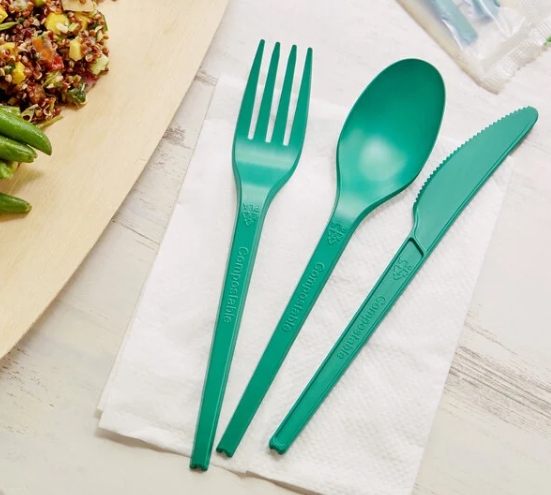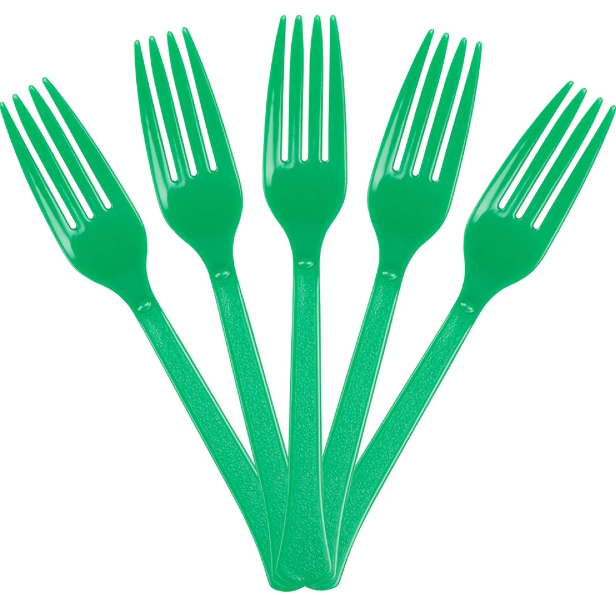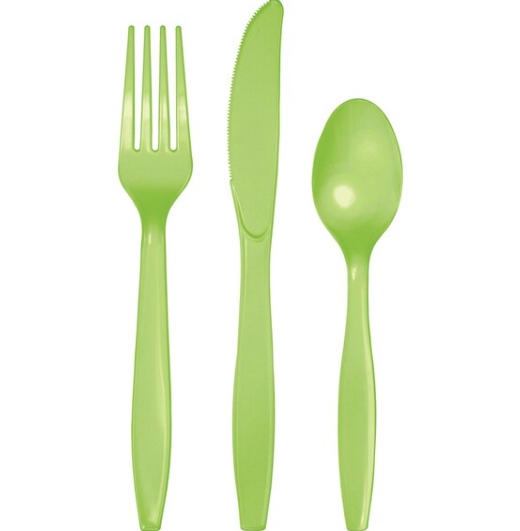
Content Menu
● What Is Green Disposable Cutlery?
>> Understanding the Concept
>> Key Features
● Materials Used in Green Disposable Cutlery
>> Wood
>> Plant Fibers
>> Bamboo
>> Paper
>> Palm Leaves
● The Environmental Impact of Traditional Disposable Cutlery
>> The Plastic Problem
● How Is Green Disposable Cutlery Eco-Friendly?
>> Biodegradability and Compostability
>> Use of Renewable Resources
>> Lower Carbon Footprint
>> Reduction of Pollution and Waste
>> Health and Safety Benefits
● Types of Green Disposable Cutlery
>> Wooden Cutlery
>> Plant Fiber Cutlery
>> Bamboo Cutlery
>> Paper Cutlery
>> Palm Leaf Cutlery
● Benefits of Using Green Disposable Cutlery
>> Environmental Benefits
>> Economic and Social Benefits
>> Practical Benefits
● Challenges and Considerations
>> Cost
>> Composting Infrastructure
>> Consumer Awareness
>> Performance
● The Future of Green Disposable Cutlery
● Conclusion
● FAQ
>> 1. What materials are commonly used in green disposable cutlery?
>> 2. How should I dispose of green disposable cutlery?
>> 3. Is green disposable cutlery as durable as plastic cutlery?
>> 4. Can green disposable cutlery be reused?
>> 5. Why is green disposable cutlery more expensive than plastic cutlery?
The world is facing an ever-growing crisis of plastic pollution, with single-use items like forks, knives, and spoons contributing significantly to the problem. In response, a new generation of eco-conscious products has emerged, including green disposable cutlery. These sustainable utensils are designed to offer the convenience of disposability while minimizing harm to the planet. But what exactly is green disposable cutlery, and how does it help create a more sustainable future? This article explores the definition, materials, environmental impact, benefits, and challenges of green disposable cutlery, as well as its role in shaping a cleaner, greener world.

What Is Green Disposable Cutlery?
Understanding the Concept
Green disposable cutlery refers to single-use eating utensils made from materials that are renewable, biodegradable, compostable, or otherwise less harmful to the environment than traditional plastics. Unlike conventional disposable cutlery, which is typically manufactured from petroleum-based plastics, green disposable cutlery is designed to break down naturally after use, leaving behind minimal or no waste.
Key Features
- Eco-Friendly Materials: Green disposable cutlery is made from resources that can be replenished or are by-products of other industries, such as agriculture.
- Biodegradability: These utensils are engineered to decompose naturally through the action of microorganisms, rather than persisting for centuries in landfills.
- Compostability: Many forms of green disposable cutlery can be composted, turning into nutrient-rich soil rather than contributing to landfill waste.
- Non-Toxic: Green disposable cutlery is free from harmful chemicals often found in plastics, making it safer for both people and the environment.
Materials Used in Green Disposable Cutlery
Wood
Wooden cutlery is crafted from fast-growing, renewable trees such as birch or bamboo. The wood is typically sourced from responsibly managed forests, ensuring that the harvesting process does not contribute to deforestation. Wooden utensils are sturdy, heat-resistant, and fully compostable.
Plant Fibers
Plant fiber cutlery is made from agricultural by-products, such as corn starch, wheat straw, or sugarcane bagasse. These materials are abundant and would otherwise be discarded, making them an efficient and sustainable choice. Plant fiber utensils are lightweight, compostable, and break down quickly in the right conditions.
Bamboo
Bamboo is one of the fastest-growing plants on earth, making it a highly renewable resource. Bamboo cutlery is strong, reusable if desired, and completely biodegradable. It requires minimal processing and no chemical treatments, further enhancing its eco-friendly credentials.
Paper
Paper-based cutlery is created using pressed paper pulp. While not as durable as wood or bamboo, paper utensils are suitable for light use and decompose rapidly. They are often chosen for large events where quick disposal is necessary.
Palm Leaves
Palm leaf cutlery is produced by molding fallen palm leaves into the shape of utensils. This process does not require additional chemicals or significant energy input, resulting in a natural, compostable product with a unique appearance.
The Environmental Impact of Traditional Disposable Cutlery
The Plastic Problem
Traditional disposable cutlery is made from petroleum-based plastics, which are derived from non-renewable fossil fuels. The production process consumes significant energy and resources, and the resulting products can persist in the environment for hundreds of years. Plastic utensils are rarely recycled due to their small size and the difficulty of cleaning them, leading to massive amounts of waste in landfills and natural habitats.
Once discarded, plastic cutlery can break down into tiny fragments known as microplastics. These particles contaminate soil, waterways, and oceans, posing a threat to wildlife and potentially entering the food chain. The environmental and health risks associated with plastic pollution have prompted a global search for more sustainable alternatives.
How Is Green Disposable Cutlery Eco-Friendly?
Biodegradability and Compostability
The defining feature of green disposable cutlery is its ability to break down naturally after use. Biodegradable utensils decompose through the action of bacteria, fungi, and other microorganisms. Compostable cutlery goes a step further, transforming into nutrient-rich compost that can be used to enrich soil. This process helps close the loop in the life cycle of materials, reducing the need for landfill space and preventing pollution.
Use of Renewable Resources
Green disposable cutlery is typically made from materials that can be replenished over time, such as fast-growing trees, bamboo, or agricultural by-products. This reduces reliance on finite fossil fuels and helps conserve natural resources for future generations. Utilizing materials like sugarcane bagasse or wheat straw also adds value to agricultural waste, supporting a circular economy.
Lower Carbon Footprint
The manufacturing process for green disposable cutlery generally requires less energy than the production of traditional plastics. Using renewable resources and efficient processing methods helps lower greenhouse gas emissions, contributing to the fight against climate change.
Reduction of Pollution and Waste
By decomposing naturally, green disposable cutlery prevents the accumulation of waste in landfills and the environment. Unlike plastic utensils, which can linger for centuries, eco-friendly alternatives leave no harmful residues and do not contribute to the growing problem of microplastic pollution.
Health and Safety Benefits
Many forms of green disposable cutlery are free from chemicals like BPA and phthalates, which are commonly found in plastics. This makes them safer for both consumers and the environment, as they do not leach toxins during use or decomposition.
Types of Green Disposable Cutlery
Wooden Cutlery
Wooden cutlery is sturdy, heat-resistant, and fully compostable. It is suitable for both hot and cold foods and is often used at eco-friendly events due to its natural appearance and durability.
Plant Fiber Cutlery
Plant fiber utensils are lightweight, compostable, and break down quickly in commercial composting facilities. They are especially popular in settings where rapid decomposition is desired.
Bamboo Cutlery
Bamboo cutlery is durable, reusable if desired, and fully biodegradable. Its strength and stylish appearance make it a favorite among eco-conscious consumers.
Paper Cutlery
Paper utensils are suitable for light use and decompose quickly, making them ideal for large events or festivals where quick disposal is necessary.
Palm Leaf Cutlery
Palm leaf cutlery is sturdy, natural, and compostable. Its unique appearance and eco-friendly production process make it a popular choice for upscale, sustainable events.

Benefits of Using Green Disposable Cutlery
Environmental Benefits
- Reduces Plastic Waste: By replacing plastic utensils with compostable alternatives, green disposable cutlery helps decrease the volume of waste entering landfills and oceans.
- Promotes Sustainable Resource Use: Utilizing renewable materials conserves natural resources and supports sustainable agriculture.
- Lowers Greenhouse Gas Emissions: The production and disposal of green disposable cutlery generate fewer emissions compared to traditional plastics.
- Prevents Pollution: Biodegradable and compostable utensils do not contribute to microplastic pollution or chemical leaching.
Economic and Social Benefits
- Supports Green Industries: The growing demand for green disposable cutlery creates opportunities for sustainable businesses and job growth in the green sector.
- Encourages Responsible Consumption: Choosing eco-friendly products fosters a culture of environmental responsibility and awareness.
- Enhances Brand Image: Businesses that use green disposable cutlery can showcase their commitment to sustainability, attracting environmentally conscious customers.
Practical Benefits
- Convenience: Green disposable cutlery offers the same convenience as traditional single-use utensils, making it easy to adopt sustainable practices without sacrificing ease of use.
- Versatility: These utensils are suitable for a wide range of settings, from casual picnics to upscale events.
Challenges and Considerations
Cost
Green disposable cutlery can be more expensive than plastic alternatives due to the cost of raw materials and processing. However, prices are decreasing as demand grows and production scales up.
Composting Infrastructure
While many forms of green disposable cutlery are compostable, they often require industrial composting facilities to break down efficiently. Access to these facilities varies by region, and not all communities have the necessary infrastructure in place.
Consumer Awareness
Educating consumers about the benefits and proper disposal of green disposable cutlery is essential for maximizing its environmental impact. Clear labeling and public awareness campaigns can help bridge the knowledge gap.
Performance
Some forms of green disposable cutlery may not be as durable as plastic, especially when used with hot or tough foods. Manufacturers are continually improving designs to enhance strength and usability.
The Future of Green Disposable Cutlery
The future of green disposable cutlery looks promising as innovation, regulation, and consumer demand drive the market forward. Researchers are developing new materials and manufacturing processes to make eco-friendly utensils more affordable, durable, and accessible. Governments and organizations are implementing bans and restrictions on single-use plastics, further accelerating the shift toward sustainable alternatives.
As composting infrastructure expands and public awareness grows, green disposable cutlery will become an increasingly common sight at events, restaurants, and homes worldwide. The transition to sustainable utensils is a crucial step in reducing plastic pollution and building a healthier planet for future generations.
Conclusion
Green disposable cutlery represents a significant advancement in the quest for sustainable living. By replacing traditional plastic utensils with products made from renewable, biodegradable, and compostable materials, individuals and businesses can dramatically reduce their environmental impact. While challenges remain in terms of cost, infrastructure, and performance, ongoing innovation and growing consumer awareness are paving the way for a greener future. Embracing green disposable cutlery is not just a practical choice-it is a meaningful step toward protecting our planet and ensuring a cleaner, healthier world for generations to come.

FAQ
1. What materials are commonly used in green disposable cutlery?
Green disposable cutlery is typically made from materials such as wood, bamboo, plant fibers (like corn starch, wheat straw, or sugarcane bagasse), paper, and palm leaves. These materials are renewable, biodegradable, and compostable, making them environmentally friendly alternatives to traditional plastics.
2. How should I dispose of green disposable cutlery?
The best disposal method for green disposable cutlery depends on the specific material. Most items can be composted in industrial composting facilities, while some may break down in home compost systems. Always check the product label for disposal instructions and local composting guidelines.
3. Is green disposable cutlery as durable as plastic cutlery?
Green disposable cutlery has improved greatly in terms of strength and durability. While some materials may not be as sturdy as plastic, especially with hot or tough foods, many options like bamboo and wood are strong enough for most uses. Manufacturers continue to enhance the performance of these products.
4. Can green disposable cutlery be reused?
Some types of green disposable cutlery, such as those made from bamboo or sturdy wood, can be reused a few times if cleaned properly. However, most are intended for single use to maintain hygiene and convenience.
5. Why is green disposable cutlery more expensive than plastic cutlery?
The higher cost of green disposable cutlery is primarily due to the sourcing of renewable materials and the manufacturing processes involved. As demand increases and production methods become more efficient, prices are expected to become more competitive with traditional plastics.

















